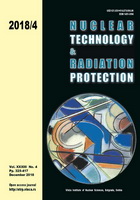
MODELING THE WATER SIDE CORROSION AND HYDROGEN PICKUP OF THE VVER 1000 FUEL CLAD

Vol.
XXXIII, No. 4, Pp. 325-417
December 2018
UDC 621.039+614.876:504.06
ISSN 1451-3994
Pages: 334-340
Authors: Leila Ramezani, Masoud Mansouri, and Mohammad RahgoshayAbstract
Zirconium alloys, are usually used as fuel cladding materials in VVER (water-cooled, water-moderated energy reactor) type reactors, mainly, due to their low neutron absorption cross-section, desirable mechanical properties, and good corrosion resistance under reactor operating conditions. During exposure to water at high temperature, water reacts with zirconium alloys, which results in the production of an oxide layer. The entire area of corrosion along with the accompanying absorption of hydrogen in the zirconium metal matrix has attracted a lot of attention when the performance of the core components as well as the operation of the reactor is emphasized. The growth of the zirconium oxide layer plays a destructive role in decreasing thermal efficiency of the reactor by restricting the inlet temperature and chemical properties of the coolant. The present study aimed to develop a computer code to predict long-term water side corrosion weight gain, oxide thickness and determine the concentration of absorbed hydrogen in VVER-1000 reactors during normal operating conditions. The proposed model can be utilized to estimate the pre-transition and post-transition corrosion weight gain and the oxide thickness in operating conditions.
Key words: fuel cladding, corrosion, zirconium oxide, hydrogen pickup
FULL PAPER IN PDF FORMAT (1.34 MB)